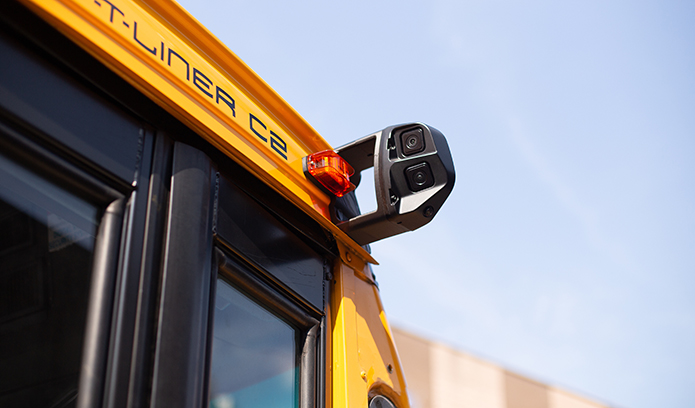
When considering new technologies, the main priority for school districts is pupil safety. Transportation providers want to embrace the latest technologies to ensure school buses remain the safest mode of transportation on the road. As one of the industry’s leading technology providers, Rosco has always been committed to developing innovative safety technologies.
Founded in 1907, Rosco Vision embraced the advancement of transportation safety. After recognizing a need for improvements in the industry’s technology offerings, Rosco introduced an improved cross-view mirror. The company soon branched out to rearview mirror systems and continued expanding its suite of products.
By the mid-2000s, Rosco Vision became the school bus industry’s standard mirror company, recognized for the improved safety aspects of its products. Today, Rosco is a leading supplier of mirrors, backup and 360 camera systems, onboard surveillance, electronic sensors, and other collision avoidance innovations for school buses.
“It is our view – and the view of the general public and government – school bus transportation is certainly one, if not the most important vehicle for safety improvements,” said Dave McDonald, vice president – business development and specifications compliance at Rosco Vision.” School buses transport children and help provide a critical facet of education. School buses are the most regulated vehicles on the road, and rightly so.”
“There is a constant stream of extraordinary new technologies that could be introduced into the school bus industry,” McDonald added. “But it is just as critical that districts are able to afford what we can offer them.”
Rosco Vision has centered its school bus efforts on a well-rounded and affordable technology suite – with a keen focus on improving safety through specialized and improved engineering processes.
Digital Camera Monitoring System (DCMS)
Rosco Vision’s newest technology advancement is the Digital Camera Monitoring System (DCMS). Utilizing cameras in place of an exterior rear-view mirror system, the DCMS will provide increased digital viewing capabilities via monitors mounted on the inside the vehicle.
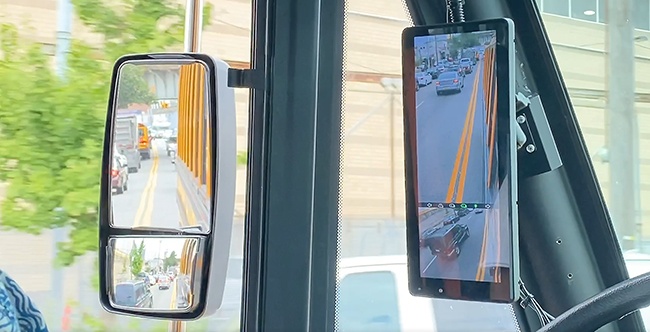
The DCMS adapts to different light conditions providing effective day and night views along with glare reduction. The system’s compact exterior cameras provide a superior field of vision and also create better aerodynamics – reducing wind resistance, which in turn lowers fuel costs.
Matthew Eckert, national school bus sales manager at Rosco Vision, said DCMS cameras decrease the vehicle’s drag coefficient, to a point where fuel savings will eventually offset the cost of the system.
The National Highway Traffic Safety Administration (NHTSA) requires that every school bus comes factory-equipped with a mirror system that meets the FMVSS 111 requirement. As such, a camera monitor system is not currently allowed to replace a district’s exterior mirrors.
However, seeking an avenue to test the technology, Rosco petitioned the Federal Motor Carrier Safety Administration (FMCSA) in November of 2021 for a five-year exemption to allow for their DCMS to be deployed on fleet vehicles that carry a Federal Department of Transportation number. In the school bus industry, this will allow Rosco’s DCMS to be tested by select private contractors once the exemption becomes effective.
“We see the DCMS as a long-term project which could really impact school buses over the next decade,” McDonald said. “Once we get the system onto buses, traveling their routes and on highways, we will be able to gather data from individual end-users to continue refining the system. Rosco is very focused on obtaining feedback from our customer base and using that data to engineer improvements, making this technology even safer and more reliable when the time comes for mass adoption.”
Safe-T-Scope 360HD™
Initially developed for school buses, the 360HD™ 3D Surround View System consists of four cameras outfitted around the vehicle’s exterior. The system’s artificial intelligence calibrates the four camera images and combines them – providing the driver with a comprehensive 360-degree composite image of the bus and its surroundings.
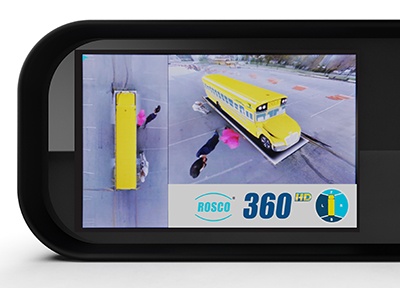
Multiple camera images, either shown together or separately, provide 2D and 3D options of full 360 or partial views of the vehicle. An HD monitor displays these views for the driver separately or stitched together.
“These cameras are 190-degree angle cameras – and they virtually eliminate blind spots for the driver,” Eckert said.
Compared to earlier analog 360 systems, the new digital 360HD system provides detailed views with increased accuracy. In addition, the new system has wider cameras which provide improved coverage for hard-to-cover areas such as the front corners of the school bus.
Eckert said that, while the new HD system has only recently been introduced to the industry, the response from districts has been overwhelmingly positive.
“We’ve upgraded the system from a 7-inch analog monitor to a 10-inch digital monitor, which is night and day from the driver’s perspective,” he said.
MOR-Vision®
MOR-Vision is Rosco Vision’s patented, integrated mirror/monitor offering, available in three standard interior mirror sizes: 6-inch by 30-inch, 10-inch by 30-inch, and 6-inch by 16-inch sizes.
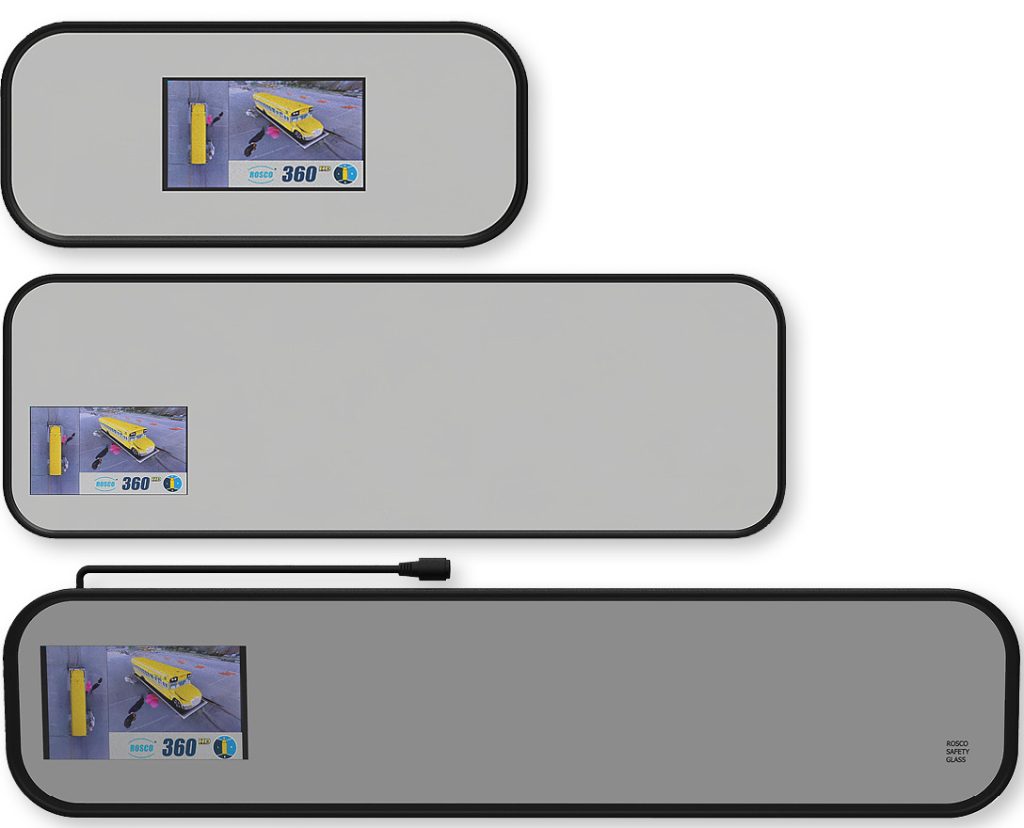
By all appearances, it is a standard rearview driver’s mirror – except MOR-Vision has a 7-inch analog or 10-inch digital monitor embedded behind its glass. When the vehicle is put into reverse, or the 180-degree, 270-degree, or 360-degree views are activated, the system provides a clear image through the mirror’s glass.
When the monitor is not in use, the image disappears behind the glass, and driver continues to have full use of the interior rearview mirror.
“It is a perfect system for school bus drivers,” Eckert said. “Regulations preventing obstructions to the driver’s field of view drastically limit mounting locations for monitors. Rosco’ MOR-Vision keeps the dashboard and windshield free from clutter. The driver is already trained to look up at that mirror, so they do not need to change their engrained behavior to utilize the system.”
MOR-Vision is approved for school buses in 48 of the 50 states.
Cross View LEDs
Rosco Vision offers a new safety enhancement to their Eye-Max® and HD® cross-view mirrors by incorporating embedded LED lighting to illuminate the front danger zone.
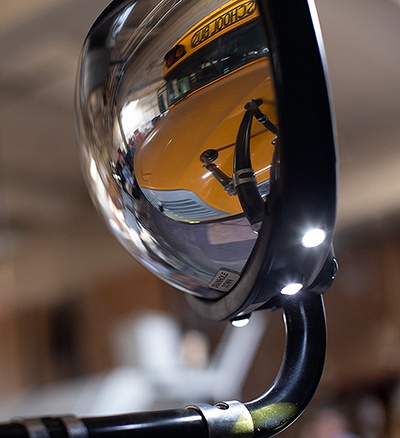 The Eye-Max® and HD® cross-view mirror systems provide enhanced definition (via a larger image) of students passing through the danger zones, reduced forward blind spots, enhanced coverage of dangerous passing traffic, and surpass System “B” mirror requirements per FMVSS 111.
The Eye-Max® and HD® cross-view mirror systems provide enhanced definition (via a larger image) of students passing through the danger zones, reduced forward blind spots, enhanced coverage of dangerous passing traffic, and surpass System “B” mirror requirements per FMVSS 111.
The new system’s LEDs brighten up the vehicle’s front area during a loading/unloading scenario in darkness or low visibility. This is especially helpful for districts as daylight grows shorter in the autumn and winter seasons.
The systems are currently triggered when the door is open, and they remain lit for 10 seconds after the door closes.
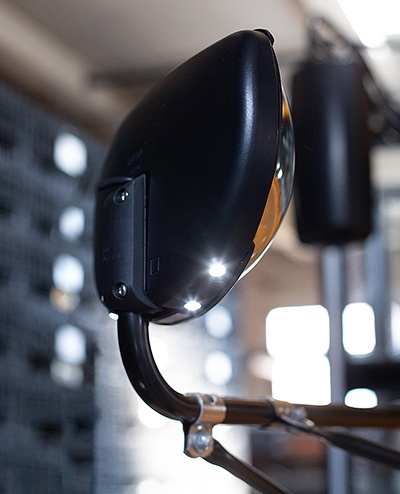 “Some drivers ask, ‘Why do I need additional lighting when my bus has headlights?’” Eckert said. “The problem is that headlights shine forward and illuminate the area 30-, 40-, or 50-feet in front of the bus – but nothing is lighting up the area immediately in front of the vehicle.”
“Some drivers ask, ‘Why do I need additional lighting when my bus has headlights?’” Eckert said. “The problem is that headlights shine forward and illuminate the area 30-, 40-, or 50-feet in front of the bus – but nothing is lighting up the area immediately in front of the vehicle.”
Rosco has optimized the cross-view LED upgrade to be deployed at the manufacturing stage, and multiple school bus OEMs are looking at the system as an optional upgrade. However, any vehicle outfitted with either Eye-Max or HD can easily be retrofitted with the new LED lighting.
The Future of School Bus Safety is Technology and Engineering
Rosco’s technology products offer the ability to integrate multiple systems, creating enhanced safety in and around the school bus.
Eckert said that while a “mirrorless bus” was once thought to be a futuristic concept, it is now completely technologically possible.
“The best attribute of technology is its unlimited ability to be enhanced for safety,” Eckert said. “If you can imagine it, you can do it. You just need to be able to think a little bit outside the box and we can start bringing those ideas to life, which is exciting.”


